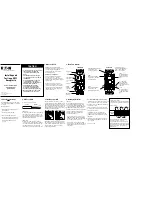
1. What is a GFCI?
A GFCI receptacle is different from
conventional receptacles. In the event of
a ground fault, a GFCI will trip and
quickly stop the flow of electricity to
prevent serious injury.
Definition of a ground fault:
Instead of following its normal safe
path, electricity passes through a
person’s body to reach the ground. For
example, a defective appliance can cause
a ground fault.
A GFCI receptacle does not protect
against circuit overloads, short circuits,
or shocks. For example, you can still be
shocked if you touch bare wires while
standing on a non-conducting surface,
such as a wood floor.
3. Should you install it?
Installing a GFCI receptacle can be more
complicated than installing a conventional
receptacle.
Make sure that you:
• Understand basic wiring principles
and techniques
• Can interpret wiring diagrams
• Have circuit wiring experience
• Are prepared to take a few minutes to
test your work, making sure that you
have wired the GFCI receptacle
correctly.
4. LINE vs. LOAD
A cable consists of 2 or 3 wires.
LINE cable:
Delivers power from the service panel (breaker
panel or fuse box) to the GFCI. If there is only
one cable entering the electrical box, it is the
LINE cable. This cable should be connected to
the GFCI’s LINE terminals only.
LOAD cable:
Delivers power from the GFCI to another
receptacle in the circuit. This cable should be
connected to the GFCI’s LOAD terminals only.
The LOAD terminals are under the yellow
sticker. Do not remove the sticker at this time.
5. Turn the power OFF
Plug an electrical device, such as a lamp
or radio, into the receptacle on which you are
working. Turn the lamp or radio on. Then, go to
the service panel. Find the breaker or fuse that
protects that receptacle. Place the breaker in
the OFF position or completely remove the fuse.
The lamp or radio must turn OFF.
6. Identify cables/wires
Important:
Do not install the GFCI receptacle in an
electrical box containing (a) more than 4
wires (not including the grounding wires)
or (b) cables with more than two wires (not
including the grounding wire). Contact a
qualified electrician if either (a) or (b) is true.
If you are replacing an old receptacle,
pull it out of the electrical box without
disconnecting the wires.
• If you see one cable (2-3 wires), it is the
LINE cable. The receptacle is probably in
position C (see diagram to the right). Remove
the receptacle and go to step 7A.
• If you see two cables (4-6 wires), follow
the procedure to the right. The receptacle
is probably in position A or B (see diagram
to the right).
Procedure: box with two cables (4-6 wires)
(a) Detach one cable’s white and hot wires from
the receptacle and cap each one separately
with a wire connector. Make sure that they are
from the same cable.
(b) Re-install the receptacle in the electrical
box, attach the faceplate, then turn the power
ON at the service panel.
(c) Determine if power is flowing to the
receptacle. If so, the capped wires are the
LOAD wires. If not, the capped wires are the
LINE wires.
(d) Turn the power OFF at the service panel,
label the LINE and LOAD wires, then remove
the receptacle.
(e) Go to step 7B.
2. The GFCI’s features
• To prevent severe shock or electrocution,
always turn the power OFF at the
service panel before working with
wiring.
• Use this GFCI receptacle with copper
or copper-clad wire. Do not use it with
aluminum wire.
• Do not install this GFCI receptacle on
a circuit that powers life support
equipment because if the GFCI trips it
will shut down the equipment.
• For installation in wet locations,
protect the GFCI receptacle with a
weatherproof cover that will keep
both the receptacle and any plugs dry.
• Must be installed in accordance with
national and local electrical codes.
CAUTION
!
Please read this leaflet
completely before
getting started.
Receptacle
Outlet
Outlet
Mounting
Bracket
RESET
button:
See step 8
TEST button:
See step 8
correct wiring/
trip
indicator
Cable
Wires
5. Turn the power OFF
Cable
Wires
Next, plug in and turn ON the lamp or radio at
the receptacle’s other outlet to make sure the
power is OFF at both outlets. If the power is not
OFF, stop work and call an electrician to
complete the installation.
Placement in circuit:
The GFCI’s place in the circuit determines if
it protects other receptacles in the circuit.
Sample circuit:
Placing the GFCI in position A will also
provide protection to “load side”
receptacles B and C. On the other hand,
placing the GFCI in position C will not provide
protection to receptacles A or B. Remember
that receptacles A, B, and C can be in
different rooms.
C
Service
Panel
B
A
LOAD
LOAD
LINE
LINE
LINE
C
Service
Panel
B
A
LOAD
LOAD
LINE
LINE
LINE
TEST RESET
TEST
MONTHLY
SEE
INSTRUCTIONS
TEST RESET
TEST
MONTHLY
SEE
INSTRUCTIONS
TEST RESET
TEST
MONTHLY
SEE
INSTRUCTIONS
OLD
NEW (2)
BACK VIEW
FRONT VIEW
Grounding Terminal (Green):
Connection for bare
copper or green wire.
Screw (terminal) colors:
Green = grounding terminal
Silver = white terminals
Brass = hot terminals
LINE
Hot terminal (Brass):
Connection for the
LINE cable’s black
wire.
LOAD
Hot terminal (Brass):
Connection for the
LOAD cable’s black
wire.
A yellow sticker
covers the LOAD
terminals. Do not
remove the sticker at
this time.
LINE
White terminal (Silver):
Connection for the LINE
cable’s white wire.
LOAD
White terminal (Silver):
Connection for the
LOAD cable’s white wire.
Installing and
Testing a GFCI
Receptacle
www.eaton.com
www.cooperwiringdevices.com
EIS-0018-E (REV. B)


